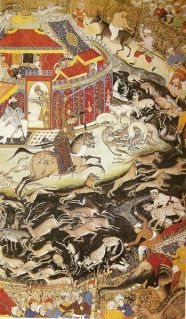This is the sort of illo the article links to, though you have to scroll down the wiki site to find it, Moghul ruler, Akbar, hunting deer from horseback:

[ " John Curtis, one of the curators, explains that there has been much advance interest in the show. Horses, magnificently wordless in themselves, excite passionate differences of opinion in their admirers and the museum has been petitioned, urging that certain breeds be championed. But the museum has faced a challenge: "Most of our exhibitions are monocultural, whereas the horse exists in all cultures." And so partly to avoid a bewildering miscellany, the decision has been taken to put Arab horses in charge of the narrative.The domestication of the horse is thought to have taken place on the western Euraisan steppes, probably in Kazakhstan, around 3,500BC (the exhibition includes what may be the earliest depiction of a horse and rider, a terracotta mound from Mesopotamia). But the narrative then advances through Islamic history and showcases the emergence of the Arab horseIt reveals that the bloodlines of modern thoroughbreds can be traced back to three Arabian stallions imported into England in the 18th century (the Darley Arabian, the Byerley Turk and the Godolphin Arabian). The journey we take includes astounding Arab rock paintings of horses and then fetches up in Victorian England to consider the horse's influence on society (the horse traffic jams were terrible), before a racy finish at Ascot and in the modern world." ]
Additionally, something we may wish to consider, which information is not included within the article, but provided by a commentator to it: this is the second exhibit at the British Museum this year sponsored by the House of Saud, i.e. see concentration on the Arab horse in history.
In the modern era museums became, among other things, the supreme expression of who holds power, and how much power is held. This has been always the case with the horse, a signature of class, rank, wealth and power.

No comments:
Post a Comment